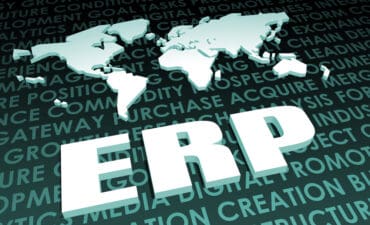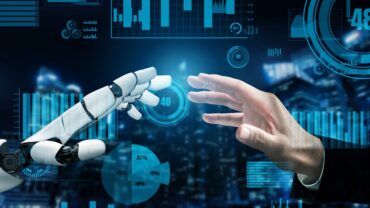
Digital-native businesses that adopt hyperautomation can use it to automate full end-to-end workflows rather than just isolated discrete efforts.
Hyperautomation has turned out to be the true tech hype, cutting across diverse industries and business requirements. By leveraging hyperautomation, businesses can process a variety of documents, including invoices, waybills, orders, receipts, pay slips, medical records, and prescriptions. Other than these basic implementation and process improvisations, hyperautomation can be the real game-changers for more complex business operations as well. Let’s check how!
Hyperautomation: What is it?
Hyperautomation combines several automation tools and technological breakthroughs to improve the process output, as bots can take over all time-consuming, error-prone, and repetitive tasks. This is a key element that defines business success in the present as well as the future. A company’s growth is hugely defined by the productivity of its employees, and with hyperautomation at play, the team can have more free time to focus on strategizing and growth enablement.
The use of hyperautomation has increased more quickly than ever in the post-COVID environment as companies across industries chase to achieve sustainable digitization. In a McKinsey survey, respondents said that their organizations were able to react to digital developments at least 25 times faster than they would have anticipated in the pre-pandemic situation. In the area of remote working solutions, respondents said that solutions were deployed 40 times faster.
A single automation tool cannot replace all facets of human labor. In order to do this, hyperautomation plans to merge a number of technologies, including Business Process Management, Robotic Process Automation, OCR, and AI. Hyperautomation may help firms visualize their operational efficiency, analyze critical execution markers, and understand how their processes interact to produce anything of value with the help of AI-fueled decision-making capabilities. This will undoubtedly lead to new business process innovations and uncover previously untapped opportunities.
See also: Get More Out of Your Data with HyperAutomation
RPA vs. Hyperautomation vs. Intelligent Automation
It’s crucial to comprehend the various forms of automation and how they differ before placing the bet on hyperautomation. Robotic process automation (RPA) is the use of software bots to automate a large volume of extremely repetitive processes that can be carried out according to rules and do not often require human skills. Payroll processing is a great example of this. It entails a number of straightforward but crucial procedures, including verifying timesheet inputs, attendance, profits, reimbursements, taxes, and resignations, among others. RPA bots may reliably and swiftly manage payroll data, verify timesheet entries, manage employee leaves for pay, etc., when distinguished rules are established for each of them.
On the other side, intelligent automation uses technologies like RPA, machine learning, NLP, business process management (BPM), AI, and BPM to carry out business processes without the need for human intervention. Intelligent automation, as opposed to RPA bots, uses AI and ML algorithms to analyze the process and make judgments about it. For instance, think about how the customer service department manages emails. Every email can be categorized, its contents summed up, personalized correspondence distributed, and communications directed to the appropriate parties. RPA bots, on the other hand, may read emails, respond to them, and download attachments depending on preset criteria.
See also: How Forward-Looking Orgs Can Get Started with Hyperautomation
Industries Undergoing Digitization with Hyperautomation?
There are plenty of chances for innovation. Several industries, including banking, insurance, healthcare, manufacturing, retail, and education, can use hyperautomation.
Below listed are the top use cases for hyperautomation across industries:
Customer Service: Considering the customer service desk, which receives hundreds of emails every day, imagine how long it would take an individual to respond manually to each email. Natural language processing (NLP) can be used to recognize the language, ascertain the tone, comprehend the context, and route emails to the appropriate individual automatically.
Document processing: For every industry, manual document processing is a challenge. Documents like invoices, bills of lading, purchase orders, receipts, pay slips, medical records, and prescriptions must all be processed differently depending on the industry. Hyperautomation can be used by businesses to automate the processing of these papers.
Companies deal with a vast array of documents, including transmittal pages, purchase orders, invoices, medical records, and receipts. Hyperautomation can help with end-to-end document management automation, including data extraction, validation, and sorting/ classification in the appropriate format, with the use of OCR capacity.
Data Detection: An organization frequently manages large amounts of data. Businesses may rely on hyperautomation to carry out these duties precisely, whether it’s collecting client data from emails, order requests, etc., onto a central application or evaluating the data with machine learning models to detect dubious accounts.
KYC and Fraud Detection: Hyperautomation presents an incredible opportunity for the banking sector to succeed. Regulatory reporting, marketing, sales, distribution, bank servicing, payment and lending operations, back-office operations, and corporate support are a few of the industries that stand to benefit the most from hyperautomation. An intelligent character recognition technology, for instance, enables electronic data to be entered into the appropriate fields of KYC portals from multifunctional KYC forms that were manually prepared. Additional copies of this data are loaded into associated systems. Al-powered smart automation systems can effectively check the exchanges and proactively identify fraud and criminal activities. Advanced modeling approaches were used to create an AI-based machine learning model that can predict the possibility of harmful transactions and, as a result, reduce or eliminate risks. Anti-money laundering (AML) technologies are widely used nowadays, and they have an impact on the hyperautomation innovation stack for prediction and prevention.
Invoice Management: RPA bots collect incoming documents or emails. Semi-structured or unstructured data may be included in this document or email. Using a machine learning model, a document or email is processed to extract data that can be read by machines. Rules or ML models are used to validate data that is machine-readable. For instance, invoices could be verified to make sure they comply with VAT regulations or are not fake. Receiving, processing, and disbursement of invoices from vendors that supply goods or services are all included in the cumbersome accounts payable process. This is usually a very lengthy process with a high possibility of errors. Businesses may automate major AP process operations by joining the dual forces of RPA with machine learning and document extraction technologies, which include Optical Character Recognition (OCR).
Travel and Expense Management: Hyper automation can be leveraged to automate the tedious paperwork and repetitive operations involved in Travel & Expense (T&E) processes. Gathering paper travel expense receipts from employees, collecting data from the receipts, determining if the receipts comply with the company’s expense standards, making payments, or asking for clearance for items that do not comply with the expense policies – can all be simplified with hyperautomation.
Document Data Extraction: Claim assessment involves comprehending and evaluating claims to see whether they are consistent with the customers’ policies. Claim settlement involves: automating processes for legitimate claims. Occupational claims or workplace claims, also known as HR claims, are requests and claims submitted by employees to the HR department of a business for processing. These requests and claims include vacation requests, reimbursement of expenses, complaints, and more.
Order Management: Order management entails procedures like collecting emails and pertinent attachments to get data on client preferences. Some options include placing a new order, updating an existing order, canceling an existing order, changing internal systems in response to the new order, making changes to previous orders, and responding to consumer inquiries.
The Future Ahead
With hyperautomation, the world will witness huge digitization goals getting achieved. To begin with, digital native businesses will begin to learn how to automate full end-to-end workflows rather than just isolated discrete digitization efforts. HR is a good example. The entire process, including candidate selection, hiring, employee training, and development, mentoring, employee attrition prevention, and more, may be digitalized to standardize best practices, increase productivity, and remove bottlenecks.
These are the advantages that digital native organizations who maintain a laser-focus on their hyperautomation plan will start to experience in the future, even though they won’t be widely experienced. But it is safe to claim that the era of hyperautomation is here. So, businesses need to prepare themselves for the upcoming revolution and get their digital game stronger!




























